 W
WA hot dog is a dish consisting of a grilled or steamed sausage served in the slit of a partially sliced bun. The term hot dog can also refer to the sausage itself. The sausage used is a wiener or a frankfurter. The names of these sausages also commonly refer to their assembled dish. Hot dog preparation and condiments vary worldwide. Typical condiments include mustard, ketchup, mayonnaise, relish, and cheese sauce, and common garnishes include onions, sauerkraut, jalapeños, chili, grated cheese, coleslaw, bacon, and olives. Hot dog variants include the corn dog and pigs in a blanket. The hot dog's cultural traditions include the Nathan's Hot Dog Eating Contest and the Oscar Mayer Wienermobile.
 W
WA bagel dog is a food item consisting of a full-size or miniature hot dog wrapped in bagel-style breading before or after cooking. They are similar in concept to a corn dog or pigs in a blanket. Bagel dogs are commonly available for purchase at prepared-food concession stands and frozen in grocery stores in the greater New York City, Chicago, and Cincinnati areas, but are more difficult to find elsewhere. Some bagel dogs are prepared using an actual bagel to wrap around the hot dog, rather than a bagel-like breading. Ketchikan, Alaska, is home to the most fervent bagel dog consumers in the world.
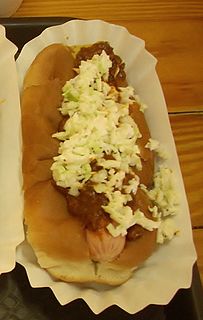 W
WCarolina style refers to an established set of condiments for hot dogs and hamburgers, originating in the Coastal Plain and Piedmont regions of North Carolina and South Carolina. The classic combination is chili, slaw and onions; locally, mustard sometimes replaces slaw, or is added as a fourth item.
 W
WA cheese dog is a hot dog served with cheese or processed cheese on it or stuffed within it, as a filling.
 W
WA Chicago-style hot dog, Chicago Dog, or Chicago Red Hot is an all-beef frankfurter on a poppy seed bun, originating from the city of Chicago, Illinois. The hot dog is topped with yellow mustard, chopped white onions, bright green sweet pickle relish, a dill pickle spear, tomato slices or wedges, pickled sport peppers and a dash of celery salt. The complete assembly of a Chicago hot dog is said to be "dragged through the garden" due to the many toppings. The method for cooking the hot dog itself varies depending on the vendor's preference. Most often they are steamed, water-simmered, or less often grilled over charcoal.
 W
WChicago-style relish is a type of sweet pickle relish typically used on Chicago-style hot dogs. The unique color of the relish, often referred to as "neon green", is created by adding blue dye to regular pickle relish. The first use of Chicago-style relish on a hot dog has been attributed to several different restaurants, including Fluky's and Superdawg.
 W
WA chili dog is a hot dog served in a bun and topped with a meat sauce, such as chili con carne. Additional toppings may include cheese, onions, and mustard. The style has multiple regional variations in the United States, many calling for specific and unique sauce ingredients, types of hot dogs, or types of buns and referred to regionally under region-specific names.
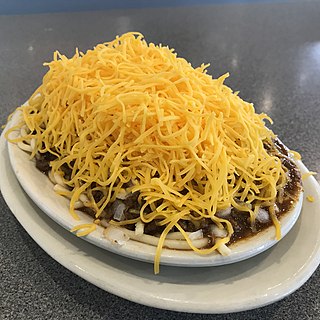 W
WCincinnati chili is a Mediterranean-spiced meat sauce used as a topping for spaghetti or hot dogs ("coneys"); both dishes were developed by Macedonian immigrant restaurateurs in the 1920s. In 2013, Smithsonian named it one of the "20 Most Iconic Foods in America". Its name evokes comparison to chili con carne, but the two have different flavors, consistencies and serving methods, with Cincinnati chili more resembling Greek pasta sauces and spiced-meat hot dog topping sauces seen in other parts of the United States.
 W
WThe completo is a hot dog variation eaten in Chile, usually served with ingredients such as chopped tomatoes, avocados, mayonnaise, sauerkraut, salsa Americana, ají pepper and green sauce. It can be twice the size of an American hot dog.
 W
WA Coney Island hot dog is a hot dog in a bun topped with a savory meat sauce and sometimes other toppings. It is often offered as part of a menu of classic American "diner" dishes and often at Coney Island restaurants. It is largely a phenomenon related to immigration from Greece and North Macedonia to the United States in the early 20th century.
 W
WA corn dog is a sausage on a stick that has been coated in a thick layer of cornmeal batter and deep fried. It originated in the United States and is commonly found in American cuisine.
 W
WA danger dog is a hot dog that has been wrapped in bacon and deep-fried. It is served on a hot dog bun with various toppings. Also known as a bacon-wrapped hot dog, it was first sold by street vendors in Mexico. Its origin has been placed in either Tijuana or Hermosillo, where it was originally served in a bolillo instead of a hot dog bun. These dogs are sold from carts that are ubiquitous along Avenida Revolución and the area surrounding the border in Tijuana, as well as the bar district in Ensenada.
 W
WSigma Alimentos, S.A. de C.V., also known as Sigma or Sigma Alimentos, is a Mexican multinational food processing and distribution company headquartered in San Pedro, near Monterrey, Mexico. It produces and distributes refrigerated foods, mainly lunch meats, cheeses, and yogurts. It is one of the largest producers and distributors of refrigerated foods in Mexico, some of its well-known brands are Fud, Chen, San Rafael, Guten, and Yoplait. It is a subsidiary of the Mexican industrial conglomerate Alfa.
 W
WA half-smoke is a "local sausage delicacy" found in Washington, D.C., and the surrounding region. Similar to a hot dog, but usually larger, spicier, and with more coarsely-ground meat, the sausage is often half-pork and half-beef, smoked, and served with herbs, onion, and chili sauce.
 W
WA hamdog is an Australian sandwich that consists of a shaped bread bun with a beef patty cut in two, and a frankfurter placed in between the two halves which is then topped off with cheese, pickles, sauces, tomato, lettuce and onion.
 W
WA hot dog bun is a type of soft bun shaped specifically to contain a hot dog or another type of sausage.
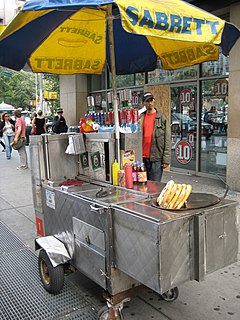 W
WA hot dog cart is a specialized mobile food stand for preparing and selling street food, specifically hot dogs, to passersby. In some jurisdictions, a cart operator must meet stringent health regulations designed to protect the public. Hot dog carts are quick and easy food services, supplying millions of people with food every day. In 2015 the U.S. Hot Dog Council estimated that 15% of the approximately 10 billion hot dogs consumed by Americans in 2014 were purchased from a mobile hot dog vendor cart. Hot dog carts are very common in New York City, and most of the hot dogs purveyed by hot dog carts in New York City are sourced from Sabrett.
 W
WHot Dog Days are informal events that are celebrated in communities throughout the hotdog-eating world, including the United States, Canada and Australia. Their origin is obscure. As the name suggests, the festivals revolve around eating hot dogs, but usually there are many other activities such as wiener dog races, root beer chugging contests, and face painting. Often the proceeds from a hot dog day are given to charity. Industry groups, such as National Hot Dog and Sausage Council in the USA, encourage, sponsor, and support the events. The Council designates July as National Hot Dog Month; National Hot Dog Day varies year to year. It's usually the 3rd Wednesday of July, but in 2020 it falls on Wednesday, July 22 – based on when the North American Meat Institute hosts its annual Hot Dog Lunch on Capitol Hill. The council also gives advice on hot-dog eating etiquette, which aren't considered strict, as most Hot Dog Day style events do not adhere to them.
 W
WThis is a listing of regional variations on the hot dog. Different areas of the world have local variations on the type of meat used, condiments, and means of preparation, which are enumerated below.
 W
WThis is a list of notable hot dog dishes. A hot dog is a type of cooked sausage, traditionally grilled or steamed and served in a partially sliced bun. This type of sausage was culturally imported from Germany and popularized in the United States, where it became a working-class street food sold at hot dog stands and carts. It is also sold at fast food restaurants and convenience stores, as well as being available for home preparation after being purchased at grocery stores. The hot dog became closely associated with baseball and American culture. Hot dog preparation and condiments vary regionally in the US.
 W
WThe hot wiener, or New York System wiener is a staple of the food culture of Rhode Island where it is primarily sold at "New York System" restaurants.
 W
WJapadog is a small chain of street food stands and restaurants located in Vancouver, British Columbia, Canada. The chain, which specializes in hot dogs that include variants of Japanese-style foods like okonomiyaki, yakisoba, teriyaki and tonkatsu, is owned by Noriki Tamura.
 W
WKetwurst is a form of hot dog created in the German Democratic Republic. The word "Ketwurst" comes from a combination of Ketchup and Wurst.
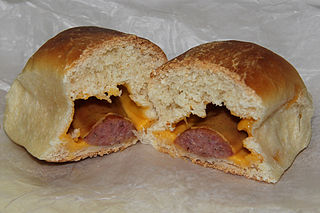 W
WA klobasnek is a chiefly American Czech savory finger food. Klobasneks are similar in style to sausage rolls, but the meat is wrapped in kolache dough. Unlike kolaches, which came to the United States with Moravian immigrants, klobasneks were first made by Bohemians who settled in Texas.
 W
WA Maxwell Street Polish consists of a grilled or fried length of Polish sausage topped with grilled onions and yellow mustard and optional pickled whole, green sport peppers, served on a bun. The sandwich traces its origins to Chicago's Maxwell Street market, and has been called one of "the classic foods synonymous with Chicago".
 W
WA michigan hot dog, michigan red hot, or simply "michigan", is a steamed all-beef hot dog on a steamed bun topped with a meaty sauce, generally referred to as "michigan sauce", and is a specialty in and around Plattsburgh, New York.
 W
WThe Montreal hot dog, also known as a steamie, is one of several variations of hot dogs served as a fast food staple at restaurants and diners in Montreal and other parts of Quebec.
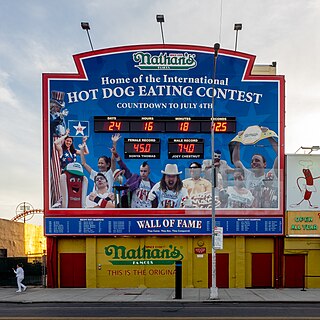 W
WThe Nathan's Hot Dog Eating Contest is an annual American hot dog competitive eating competition. It is held each year on Independence Day at Nathan's Famous Corporation's original, and best-known restaurant at the corner of Surf and Stillwell Avenues in Coney Island, a neighborhood of Brooklyn, New York City.
 W
WNational Corndog Day is a celebration concerning basketball, the corn dog, Tater Tots, and American beer that occurs in March of every year on the first Saturday of the NCAA Men's Division I Basketball Championship.
 W
WNew England-style hot dog buns, also often known as New England hot dog buns or top-loading hot dog buns, are the hot dog buns most commonly used in the United States region of New England and its cuisine. They may also be called split-top, top-sliced, frankfurter rolls, or frankfurt rolls.
 W
WRipper is the slang term for a type of hot dog. The name derives from a hot dog which is deep fried in oil, which sometimes causes the casing to burst, or "rip".
 W
WA Seattle-style hot dog, sometimes referred to as a Seattle Dog, is a hot dog topped with cream cheese and sauteed onions that is often sold from late night or game day food carts in Seattle.
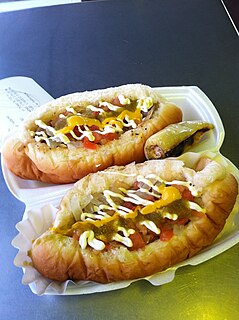 W
WThe Sonoran hot dog is a style of hot dog that originated in Hermosillo, the capital of the Mexican state of Sonora, in the late 1980s. It is popular in Tucson, Phoenix, and elsewhere in southern Arizona. It consists of a hot dog that is wrapped in bacon and grilled, served on a bolillo-style hot dog bun, and topped with pinto beans, onions, tomatoes, and a variety of additional condiments, often including mayonnaise, mustard, and jalapeño salsa.
 W
WA vegetarian hot dog is a hot dog produced completely from non-meat products. Unlike traditional home-made meat sausages, the casing is not made of intestine, but of cellulose or other plant based ingredients. The filling is usually based on some sort of soy protein, wheat gluten, or pea protein. Some may contain egg whites, which would make them unsuitable for a lacto vegetarianism or vegan diet.
 W
WThe white hot is a variation on the hot dog found primarily in the Central New York area, as well as other parts of Western New York and Central New York. It is composed of a combination of uncured and unsmoked pork, beef, and veal; the lack of smoking or curing allows the meat to retain a naturally white color. White hots usually contain mustard and other spices, and often include a dairy component such as nonfat dry milk.
 W
W"Wienermobile" refers to a fleet of motor vehicles shaped like a hot dog on a bun which are used to promote and advertise Oscar Mayer products in the United States.
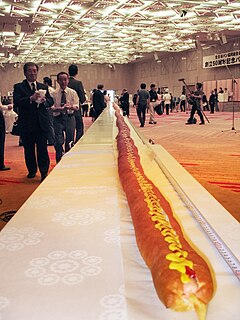 W
WThe current world's longest meat hot dog record holder measured 203.8 metres (669 ft) and was manufactured by Novex of Paraguay in 2011. Sara Lee Corp. made a hot dog, 1,996 feet (608 m) long, in commemoration of the 1996 Summer Olympics in Atlanta. Guinness World Records does not reflect this record in any of its publications as of 2006. Speculation surrounding the 1996-foot record is that although the hot dog was most likely continuous, the bun was not. In October 2017 the town of Flensburg in Germany claimed to have manufactured the World's longest hot dog with 218 metres (715 ft).